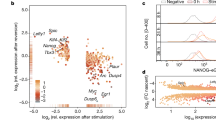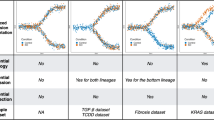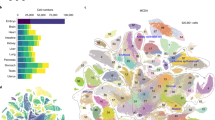Abstract
Molecular regulation of embryonic stem cell (ESC) fate involves a coordinated interaction between epigenetic1,2,3,4, transcriptional5,6,7,8,9,10 and translational11,12 mechanisms. It is unclear how these different molecular regulatory mechanisms interact to regulate changes in stem cell fate. Here we present a dynamic systems-level study of cell fate change in murine ESCs following a well-defined perturbation. Global changes in histone acetylation, chromatin-bound RNA polymerase II, messenger RNA (mRNA), and nuclear protein levels were measured over 5 days after downregulation of Nanog, a key pluripotency regulator13,14,15. Our data demonstrate how a single genetic perturbation leads to progressive widespread changes in several molecular regulatory layers, and provide a dynamic view of information flow in the epigenome, transcriptome and proteome. We observe that a large proportion of changes in nuclear protein levels are not accompanied by concordant changes in the expression of corresponding mRNAs, indicating important roles for translational and post-translational regulation of ESC fate. Gene-ontology analysis across different molecular layers indicates that although chromatin reconfiguration is important for altering cell fate, it is preceded by transcription-factor-mediated regulatory events. The temporal order of gene expression alterations shows the order of the regulatory network reconfiguration and offers further insight into the gene regulatory network. Our studies extend the conventional systems biology approach to include many molecular species, regulatory layers and temporal series, and underscore the complexity of the multilayer regulatory mechanisms responsible for changes in protein expression that determine stem cell fate.
This is a preview of subscription content, access via your institution
Access options
Subscribe to this journal
Receive 51 print issues and online access
$199.00 per year
only $3.90 per issue
Buy this article
- Purchase on Springer Link
- Instant access to full article PDF
Prices may be subject to local taxes which are calculated during checkout




Similar content being viewed by others
References
Bernstein, B. E. et al. A bivalent chromatin structure marks key developmental genes in embryonic stem cells. Cell 125, 315–326 (2006)
Boyer, L. A. et al. Polycomb complexes repress developmental regulators in murine embryonic stem cells. Nature 441, 349–353 (2006)
Mikkelsen, T. S. et al. Genome-wide maps of chromatin state in pluripotent and lineage-committed cells. Nature 448, 553–560 (2007)
Meissner, A. et al. Genome-scale DNA methylation maps of pluripotent and differentiated cells. Nature 454, 766–770 (2008)
Boyer, L. A. et al. Core transcriptional regulatory circuitry in human embryonic stem cells. Cell 122, 947–956 (2005)
Loh, Y. H. et al. The Oct4 and Nanog transcription network regulates pluripotency in mouse embryonic stem cells. Nature Genet. 38, 431–440 (2006)
Ivanova, N. et al. Dissecting self-renewal in stem cells with RNA interference. Nature 442, 533–538 (2006)
Kim, J., Chu, J., Shen, X., Wang, J. & Orkin, S. H. An extended transcriptional network for pluripotency of embryonic stem cells. Cell 132, 1049–1061 (2008)
Chickarmane, V. & Peterson, C. A computational model for understanding stem cell, trophectoderm and endoderm lineage determination. PLoS One 3, e3478 (2008)
Ying, Q. L. et al. The ground state of embryonic stem cell self-renewal. Nature 453, 519–523 (2008)
Sampath, P. et al. A hierarchical network controls protein translation during murine embryonic stem cell self-renewal and differentiation. Cell Stem Cell 2, 448–460 (2008)
Chang, W. Y. & Stanford, W. L. Translational control: a new dimension in embryonic stem cell network analysis. Cell Stem Cell 2, 410–412 (2008)
Chambers, I. et al. Functional expression cloning of Nanog, a pluripotency sustaining factor in embryonic stem cells. Cell 113, 643–655 (2003)
Mitsui, K. et al. The homeoprotein Nanog is required for maintenance of pluripotency in mouse epiblast and ES cells. Cell 113, 631–642 (2003)
Chambers, I. et al. Nanog safeguards pluripotency and mediates germline development. Nature 450, 1230–1234 (2007)
Unwin, R. D. et al. Quantitative proteomics reveals posttranslational control as a regulatory factor in primary hematopoietic stem cells. Blood 107, 4687–4694 (2006)
Spooncer, E. et al. Developmental fate determination and marker discovery in hematopoietic stem cell biology using proteomic fingerprinting. Mol. Cell. Proteomics 7, 573–581 (2008)
van den Berg, D. L. et al. Estrogen-related receptor β interacts with Oct4 to positively regulate Nanog gene expression. Mol. Cell. Biol. 28, 5986–5995 (2008)
Tay, Y., Zhang, J., Thomson, A. M., Lim, B. & Rigoutsos, I. MicroRNAs to Nanog, Oct4 and Sox2 coding regions modulate embryonic stem cell differentiation. Nature 455, 1124–1128 (2008)
Marson, A. et al. Connecting microRNA genes to the core transcriptional regulatory circuitry of embryonic stem cells. Cell 134, 521–533 (2008)
Bonifer, C., Hoogenkamp, M., Krysinska, H. & Tagoh, H. How transcription factors program chromatin—lessons from studies of the regulation of myeloid-specific genes. Semin. Immunol. 20, 257–263 (2008)
Takahashi, K. & Yamanaka, S. Induction of pluripotent stem cells from mouse embryonic and adult fibroblast cultures by defined factors. Cell 126, 663–676 (2006)
Okita, K., Ichisaka, T. & Yamanaka, S. Generation of germline-competent induced pluripotent stem cells. Nature 448, 313–317 (2007)
Wang, J. et al. A protein interaction network for pluripotency of embryonic stem cells. Nature 444, 364–368 (2006)
Macarthur, B. D., Ma’ayan, A. & Lemischka, I. R. Systems biology of stem cell fate and cellular reprogramming. Nature Rev. Mol. Cell Biol. 10, 672–681 (2009)
Graf, T. & Stadtfeld, M. Heterogeneity of embryonic and adult stem cells. Cell Stem Cell 3, 480–483 (2008)
Dietrich, J. E. & Hiiragi, T. Stochastic patterning in the mouse pre-implantation embryo. Development 134, 4219–4231 (2007)
Singh, A. M., Hamazaki, T., Hankowski, K. E. & Terada, N. A heterogeneous expression pattern for Nanog in embryonic stem cells. Stem Cells 25, 2534–2542 (2007)
Kalmar, T. et al. Regulated fluctuations in Nanog expression mediate cell fate decisions in embryonic stem cells. PLoS Biol. 7, e1000149 (2009)
Airoldi, E. M. Getting started in probabilistic graphical models. PLOS Comput. Biol. 3, e252 (2007)
Liu, C. L., Schreiber, S. L. & Bernstein, B. E. Development and validation of a T7 based linear amplification for genomic DNA. BMC Genomics 4, 19 (2003)
Kislinger, T. et al. Global survey of organ and organelle protein expression in mouse: combined proteomic and transcriptomic profiling. Cell 125, 173–186 (2006)
Ritchie, M. E. et al. A comparison of background correction methods for two-colour microarrays. Bioinformatics 23, 2700–2707 (2007)
Yang, Y. H. et al. Normalization for cDNA microarray data: a robust composite method addressing single and multiple slide systematic variation. Nucleic Acids Res. 30, e15 (2002)
Smyth, G. K. Linear models and empirical bayes methods for assessing differential expression in microarray experiments. Stat. Appl. Genet. Mol. Biol. 3, Article3 (2004)
Benjamini, Y., Drai, D., Elmer, G., Kafkafi, N. & Golani, I. Controlling the false discovery rate in behavior genetics research. Behav. Brain Res. 125, 279–284 (2001)
Eichler, G. S., Huang, S. & Ingber, D. E. Gene Expression Dynamics Inspector (GEDI): for integrative analysis of expression profiles. Bioinformatics 19, 2321–2322 (2003)
Acknowledgements
We would like to thank D. Storton for technical support, and E. Wieschaus, Y. Shi, S. Tavazoie and N. Slavov for constructive discussions. We also acknowledge the laboratories of the following people for providing antibodies for western blot: A. Okuda, J. Flint and Y. Kang. This work was supported by the NIH, and in part supported by the BBSRC and Leukaemia Research UK. O.G.T., F.M. and E.M.A. were partially supported by the NIH and US National Science Foundation.
Author Contributions R.L. and I.R.L. designed the experiments. R.L. prepared the cell samples for all the experiments, performed the RNA polymerase II ChIP-chip, the mRNA microarray, and verification experiments such as western blot, ChIP and quantitative PCR. R.D.U. and A.D.W. performed the proteomic experiments and primary analysis on proteomic data. L.A.B. performed the histone acetylation ChIP-chip experiments. R.L., F.M., E.M.A., R.R. and O.G.T. performed general data processing and statistical analyses. R.L. and F.M. plotted Figs 1– 3. A.L., B.D.M. and A.M. developed and plotted interactive Fig. 4a. A.L. and A.M. developed and plotted interactive Fig. 4b. R.L., J.L., F.M. and I.R.L performed network analysis shown in Fig. 3. R.L. and I.R.L. wrote the paper.
Author information
Authors and Affiliations
Corresponding authors
Supplementary information
Supplementary Information
This file contains Supplementary Figures 1-12 with Legends, Supplementary Data, Legends for Supplementary Movies 1-7 and Supplementary References. Please note that Supplementary Figure 8 is an interactive version of Figure 4 in the main paper and requires Adobe Reader 9 or higher. Alternatively, see Supplementary Movies, files 1-7. This file was replaced on December 24 2009 to add the missing link for the Raw Data files as described on page 18. (PDF 7270 kb)
Supplementary Movie 1
This movie file is an interactive movie of figure 4 a in the main paper. (SWF 1404 kb)
Supplementary Movie 2
This movie file is an interactive movie of figure 4 b in the main paper. (SWF 707 kb)
Supplementary Movie 3
This movie file is an interactive movie of figure 4 b in the main paper. (SWF 706 kb)
Supplementary Movie 4
This movie file is an interactive movie of figure 4 b in the main paper. (SWF 707 kb)
Supplementary Movie 5
This movie file is an interactive movie of figure 4 b in the main paper. (SWF 718 kb)
Supplementary Movie 6
This movie file is an interactive movie of figure 4 b in the main paper. (SWF 719 kb)
Supplementary Movie 7
This movie file is an interactive movie of figure 4 b in the main paper. (SWF 718 kb)
Rights and permissions
About this article
Cite this article
Lu, R., Markowetz, F., Unwin, R. et al. Systems-level dynamic analyses of fate change in murine embryonic stem cells. Nature 462, 358–362 (2009). https://doi.org/10.1038/nature08575
Received:
Accepted:
Issue Date:
DOI: https://doi.org/10.1038/nature08575
This article is cited by
-
RSL24D1 sustains steady-state ribosome biogenesis and pluripotency translational programs in embryonic stem cells
Nature Communications (2023)
-
Argininosuccinate lyase is a metabolic vulnerability in breast development and cancer
npj Systems Biology and Applications (2021)
-
Hyperthermia depletes Oct4 in mouse blastocysts and stem cells
Stem Cell Research & Therapy (2020)
-
A translational program that suppresses metabolism to shield the genome
Nature Communications (2020)
-
The translational landscape of ground state pluripotency
Nature Communications (2020)
Comments
By submitting a comment you agree to abide by our Terms and Community Guidelines. If you find something abusive or that does not comply with our terms or guidelines please flag it as inappropriate.



